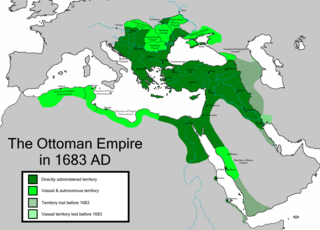| Ottoman Turkish | |
|---|---|
| لسان عثمانی Lisân-ı Osmânî | |
 | |
| Region | Ottoman Empire |
| Ethnicity | Ottoman Turks |
| Era | c. 15th century; developed into modern Turkish in 1928[1] |
Turkic
| |
Early form | |
| Ottoman Turkish alphabet | |
| Official status | |
Official language in | |
| Language codes | |
| ISO 639-2 | ota |
| ISO 639-3 | ota |
ota | |
| Glottolog | otto1234 |
 The Ottoman Empire was at its peak, Ottoman Turkish culture including the language also developed in the conquered areas | |
Ottoman Turkish (Ottoman Turkish: لِسانِ عُثمانی, romanized: Lisân-ı Osmânî, Turkish pronunciation: [liˈsaːnɯ osˈmaːniː]; Turkish: Osmanlı Türkçesi) was the standardized register of the Turkish language in the Ottoman Empire (14th to 20th centuries CE). It borrowed extensively, in all aspects, from Arabic and Persian. It was written in the Ottoman Turkish alphabet. Ottoman Turkish was largely unintelligible to the less-educated lower-class and to rural Turks, who continued to use kaba Türkçe ("raw/vulgar Turkish"; compare Vulgar Latin and Demotic Greek), which used far fewer foreign loanwords and is the basis of the modern standard.[3] The Tanzimât era (1839–1876) saw the application of the term "Ottoman" when referring to the language[4] (لسان عثمانی lisân-ı Osmânî or عثمانلیجه Osmanlıca); Modern Turkish uses the same terms when referring to the language of that era (Osmanlıca and Osmanlı Türkçesi). More generically, the Turkish language was called تركچه Türkçe or تركی Türkî "Turkish".
- ^ "Turkey – Language Reform: From Ottoman To Turkish". Countrystudies.us. Archived from the original on 9 April 2016. Retrieved 24 May 2016.
- ^ "5662". DergiPark.
- ^ Glenny, Misha (2001). The Balkans — Nationalism, War, and the Great Powers, 1804–1999. Penguin. p. 99.
- ^ Kerslake, Celia (1998). "Ottoman Turkish". In Lars Johanson; Éva Á. Csató (eds.). Turkic Languages. New York: Routledge. p. 108. ISBN 0415082005.
Cite error: There are <ref group=lower-alpha> tags or {{efn}} templates on this page, but the references will not show without a {{reflist|group=lower-alpha}} template or {{notelist}} template (see the help page).